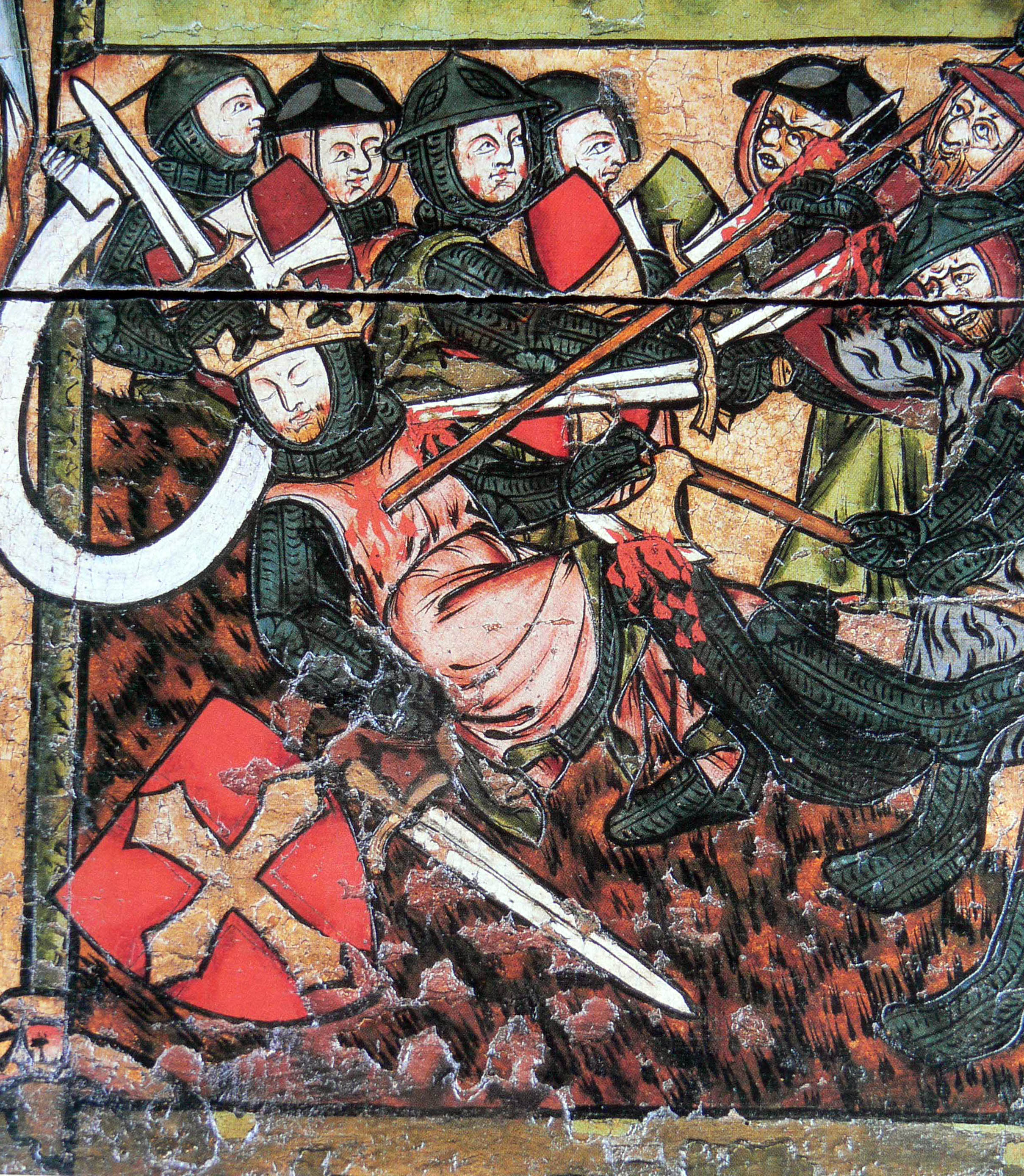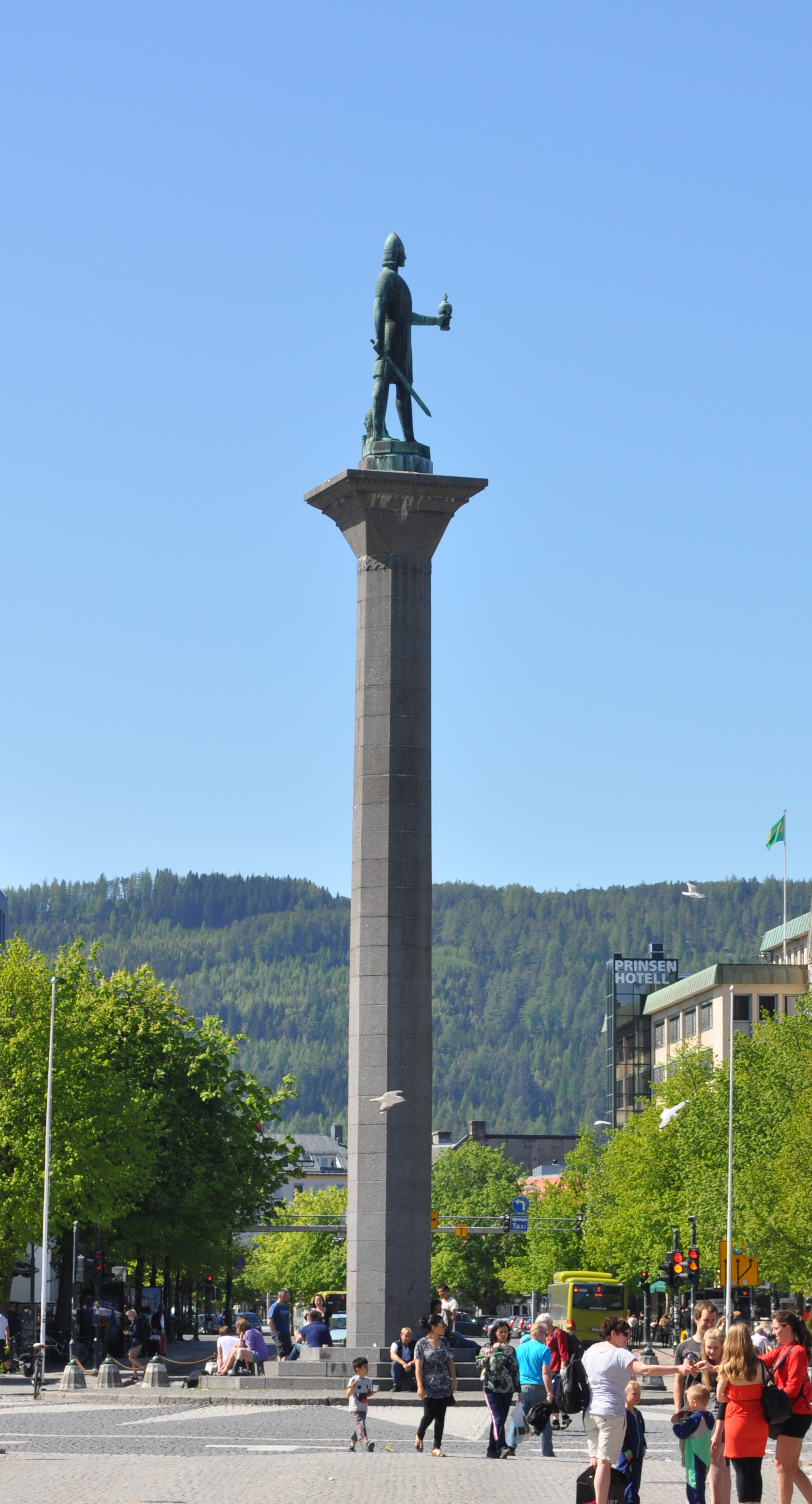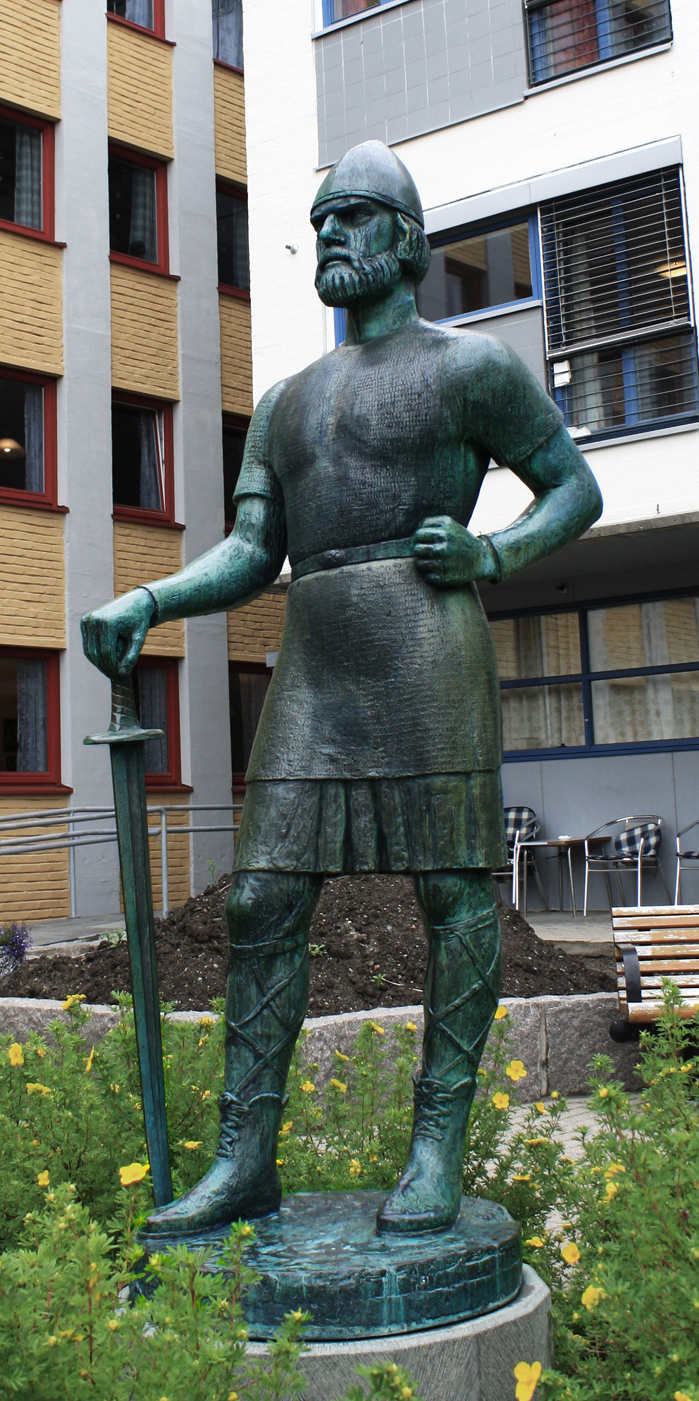|
Battle Of Stiklestad
The Battle of Stiklestad ( no, Slaget på Stiklestad, non, Stiklarstaðir) in 1030 is one of the most famous battles in the history of Norway. In this battle, King Olaf II of Norway () was killed. During the pontificate of Pope Alexander III, the Roman Catholic Church declared Olaf a saint in 1164. His younger half-brother, Harald Hardrada (), was also present at the battle. Harald was only fifteen when the battle of Stiklestad took place. He became King of Norway in 1047, until his death in a failed invasion of England at the Battle of Stamford Bridge in 1066. The authenticity of the battle as a historical event is subject to question. Contemporary sources say the king was murdered. According to the ''Anglo Saxon Chronicle'' of 1030, Olaf was killed by his own people. Adam of Bremen wrote in 1070 that Olaf was killed in an ambush, and so did Florence of Worcester in 1100. Those are the only contemporary sources that mention the death of the king. After the king's canoni ... [...More Info...] [...Related Items...] OR: [Wikipedia] [Google] [Baidu] |
Stiklestad
Stiklestad is a village and parish in the municipality of Verdal in Trøndelag county, Norway. It is located east of the town of Verdalsøra and about southeast of the village of Forbregd/Lein. The village is mainly known as the site of the Battle of Stiklestad on 29 July 1030. Stiklestad Church is located in the village and it is assumed to have been erected on the exact spot where King Olaf II Haraldsson fell in the battle. The king was buried in Nidaros (Trondheim), canonised there on 3 August 1031, and later enshrined in Nidaros Cathedral. Following the Lutheran reformation of 1537 the saint's remains were removed and their precise resting-place has been unknown since 1568. Name The Old Norse form of the name is ''Stiklarstaðir''. The first element is the genitive of a word ''stikl'' and the last element is ''staðir'' which means "farm". The word ''stikl'' might have been derived from the verb ''stikla'' which means "to jump", and this might have been the name of ... [...More Info...] [...Related Items...] OR: [Wikipedia] [Google] [Baidu] |
Fief
A fief (; la, feudum) was a central element in medieval contracts based on feudal law. It consisted of a form of property holding or other rights granted by an overlord to a vassal, who held it in fealty or "in fee" in return for a form of feudal allegiance, services and/or payments. The fees were often lands, land revenue or revenue-producing real property like a watermill, held in feudal land tenure: these are typically known as fiefs or fiefdoms. However, not only land but anything of value could be held in fee, including governmental office, rights of exploitation such as hunting, fishing or felling trees, monopolies in trade, money rents and tax farms. There never did exist one feudal system, nor did there exist one type of fief. Over the ages, depending on the region, there was a broad variety of customs using the same basic legal principles in many variations. Terminology In ancient Rome, a " benefice" (from the Latin noun , meaning "benefit") was a gift of l ... [...More Info...] [...Related Items...] OR: [Wikipedia] [Google] [Baidu] |
Battle Of Nesjar
Battle of Nesjar (''Slaget ved Nesjar'') was a sea battle off the coast of Norway in 1016. It was a primary event in the reign of King Olav Haraldsson (later Saint Olav). Icelandic skald and court poet Sigvatr Þórðarson composed the poem ''Nesjavísur'' in memory of the battle. A monument known as the Nesjar Monument was erected on the 1000th anniversary of the battle, located in Helgeroa village in Larvik , Vestfold County, where the battle is believed to have occurred. Historic record Tradition places the location of the battle in west end of Oslofjord, possibly near . The exact location is unknown, but it is somewhere in today's Langesundfjorden inlet in Frierfjord near Brunlanes, Larvik in Vestfold. The fighting parties were the throne claimant Olav Haraldsson on one side and an alliance backing the Swedish vassal Sveinn Hákonarson on the other. After the defeat of Olav Tryggvason at the Battle of Svolder, Norway had been divided into a Swedish part governed by ... [...More Info...] [...Related Items...] OR: [Wikipedia] [Google] [Baidu] |
Viking
Vikings ; non, víkingr is the modern name given to seafaring people originally from Scandinavia (present-day Denmark, Norway and Sweden), who from the late 8th to the late 11th centuries raided, pirated, traded and settled throughout parts of Europe.Roesdahl, pp. 9–22. They also voyaged as far as the Mediterranean, North Africa, Volga Bulgaria, the Middle East, and North America. In some of the countries they raided and settled in, this period is popularly known as the Viking Age, and the term "Viking" also commonly includes the inhabitants of the Scandinavian homelands as a collective whole. The Vikings had a profound impact on the early medieval history of Scandinavia, the British Isles, France, Estonia, and Kievan Rus'. Expert sailors and navigators aboard their characteristic longships, Vikings established Norse settlements and governments in the British Isles, the Faroe Islands, Iceland, Greenland, Normandy, and the Baltic coast, as well as alo ... [...More Info...] [...Related Items...] OR: [Wikipedia] [Google] [Baidu] |
Sweyn Forkbeard
Sweyn Forkbeard ( non, Sveinn Haraldsson tjúguskegg ; da, Svend Tveskæg; 17 April 963 – 3 February 1014) was King of Denmark from 986 to 1014, also at times King of the English and King of Norway. He was the father of King Harald II of Denmark, King Cnut the Great, and Queen Estrid Svendsdatter. In the mid-980s, Sweyn revolted against his father, Harald Bluetooth, and seized the throne. Harald was driven into exile and died shortly afterwards in November 986 or 987. In 1000, with the allegiance of Eric, Earl of Lade, Sweyn ruled most of Norway. In 1013, shortly before his death, he became the first Danish king of the English after a long effort. Biography Historiographical sources on Sweyn's life include the '' Anglo-Saxon Chronicle'' (where his name is rendered as ''Swegen''), Adam of Bremen's 11th-century '' Deeds of the Bishops of Hamburg'', and Snorri Sturluson's 13th-century '' Heimskringla''. Conflicting accounts of Sweyn's later life also appear in the '' ... [...More Info...] [...Related Items...] OR: [Wikipedia] [Google] [Baidu] |
Denmark
) , song = ( en, "King Christian stood by the lofty mast") , song_type = National and royal anthem , image_map = EU-Denmark.svg , map_caption = , subdivision_type = Sovereign state , subdivision_name = Kingdom of Denmark , established_title = Consolidation , established_date = 8th century , established_title2 = Christianization , established_date2 = 965 , established_title3 = , established_date3 = 5 June 1849 , established_title4 = Faroese home rule , established_date4 = 24 March 1948 , established_title5 = EEC accession , established_date5 = 1 January 1973 , established_title6 = Greenlandic home rule , established_date6 = 1 May 1979 , official_languages = Danish , languages_type = Regional languages , languages_sub = yes , languages = GermanGerman is recognised as a protected minority language in the South Jutland area of Denmark. , demonym = , capital = Copenhagen , largest_city = capital , coordinates = , ethnic_groups = , ethnic_gr ... [...More Info...] [...Related Items...] OR: [Wikipedia] [Google] [Baidu] |
Eiríkr Hákonarson
Erik Hakonsson, also known as Eric of Hlathir or Eric of Norway, (, 960s – 1020s) was Earl of Lade, Governor of Norway and Earl of Northumbria. He was the son of Earl Hákon Sigurðarson and brother of the legendary Aud Haakonsdottir of Lade. He participated in the Battle of Hjörungavágr, the Battle of Svolder and the conquest of England by King Canute the Great. Name Eric is referred to in various ways in the medieval sources and by modern scholars. He most commonly witnessed charters as ''Yric dux'' ("Duke Eric") but his name is also spelled ''Yric'', ''Yrric'', ''Iric'', ''Eiric'' or ''Eric'' in 11th-century Latin and Old English sources. In Old Norse sources, using normalized orthography, he is most commonly ''Eiríkr jarl'' ("Earl Eric") or ''Eiríkr jarl Hákonarson'', but sometimes as ''Eirekr''. Modern historians usually use a variant of Eiríkr/Eirik/Eric and his patronym, Hákonarson/Hakonarson/Hakonson, meaning "son of Haakon". In modern Norwegian, it woul ... [...More Info...] [...Related Items...] OR: [Wikipedia] [Google] [Baidu] |
Sveinn Hákonarson
Sweyn Haakonsson ( Old Norse: ''Sveinn Hákonarson'', no, Svein Håkonsson) (died c. 1016) was an earl of the house of Hlaðir and co-ruler of Norway from 1000 to c. 1015. He was the son of earl Hákon Sigurðarson. He is first mentioned in connection with the battle of Hjörungavágr, where the ''Heimskringla'' says he commanded 60 ships. After the battle of Svolder in the year 1000, Sveinn became co-ruler of Norway with his half-brother, Eiríkr Hákonarson. After Eiríkr went to England in 1014, Sveinn was co-ruler with Hákon Eiríksson. In 1015, Óláfr Haraldsson arrived in Norway and claimed the throne. He defeated Sveinn and his allies in the battle of Nesjar. Sveinn retreated to Sweden, intending to muster a force to retake Norway but he died of an illness before he could return. Sveinn married Hólmfríðr, who was either the daughter or sister of king Óláfr of Sweden. They had the daughter Sigríðr, who was married to Áslákr, son of Erlingr Skjálgsson. Another ... [...More Info...] [...Related Items...] OR: [Wikipedia] [Google] [Baidu] |
Christianity
Christianity is an Abrahamic monotheistic religion based on the life and teachings of Jesus of Nazareth. It is the world's largest and most widespread religion with roughly 2.38 billion followers representing one-third of the global population. Its adherents, known as Christians, are estimated to make up a majority of the population in 157 countries and territories, and believe that Jesus is the Son of God, whose coming as the messiah was prophesied in the Hebrew Bible (called the Old Testament in Christianity) and chronicled in the New Testament. Christianity began as a Second Temple Judaic sect in the 1st century Hellenistic Judaism in the Roman province of Judea. Jesus' apostles and their followers spread around the Levant, Europe, Anatolia, Mesopotamia, the South Caucasus, Ancient Carthage, Egypt, and Ethiopia, despite significant initial persecution. It soon attracted gentile God-fearers, which led to a departure from Jewish customs, and, after t ... [...More Info...] [...Related Items...] OR: [Wikipedia] [Google] [Baidu] |
Olaf Tryggvason
Olaf Tryggvason (960s – 9 September 1000) was King of Norway from 995 to 1000. He was the son of Tryggvi Olafsson, king of Viken ( Vingulmark, and Rånrike), and, according to later sagas, the great-grandson of Harald Fairhair, first King of Norway. He is numbered as Olaf I. Olaf is seen as an important factor in the conversion of the Norse to Christianity. He is said to have built the first Christian church in Norway, in 995, and to have founded the city of Trondheim in 997. A statue of Olaf Tryggvason is located in the city's central plaza. Historical information on Olaf is sparse. He is mentioned in some contemporary English sources, and some skaldic poems. The oldest narrative source mentioning him briefly is Adam of Bremen's '' Gesta Hammaburgensis ecclesiae pontificum'' of ''circa'' 1070. In the 1190s, two Latin versions of ''"Óláfs saga Tryggvasonar"'' were written in Iceland, by Oddr Snorrason and by Gunnlaugr Leifsson – these are now lost, but are thought to fo ... [...More Info...] [...Related Items...] OR: [Wikipedia] [Google] [Baidu] |
Haakon The Good
Haakon Haraldsson (c. 920–961), also Haakon the Good (Old Norse: ''Hákon góði'', Norwegian: ''Håkon den gode'') and Haakon Adalsteinfostre (Old Norse: ''Hákon Aðalsteinsfóstri'', Norwegian: ''Håkon Adalsteinsfostre''), was the king of Norway from 934 to 961. He was noted for his attempts to introduce Christianity into Norway. Early life Haakon is not mentioned in any narrative sources earlier than the late 12th century. According to this late saga tradition, Haakon was the youngest son of King Harald Fairhair and Thora Mosterstang. He was born on the Håkonshella peninsula in Hordaland. King Harald determined to remove his youngest son out of harm's way and accordingly sent him to the court of King Athelstan of England. Haakon was fostered by King Athelstan, as part of an agreement made by his father, for which reason Haakon was nicknamed ''Adalsteinfostre''. According to the Sagas, Athelstan was tricked into fostering Haakon when Harald's envoy used the custom of k ... [...More Info...] [...Related Items...] OR: [Wikipedia] [Google] [Baidu] |
Jarls Of Lade
The Earls of Lade ( no, ladejarler) were a dynasty of Norse '' jarls'' from Lade (Old Norse: ''Hlaðir''), who ruled what is now Trøndelag and Hålogaland from the 9th century to the 11th century. The seat of the Earls of Lade was at Lade Gaard, now located in the eastern parts of the city of Trondheim. The site is near the seaside of the Trondheimsfjord, which was an important waterway in the Viking Age. According to Snorri, King Harald I of Norway was a great commander but lacked a fleet. For that he was assisted by Håkon Grjotgardsson. In gratitude Harald made him the first earl of Lade. Notable Earls of Lade * Hákon Grjótgarðsson (c. 860–870 – c. 900–920), an ally and father-in-law of Harald Fairhair * Sigurðr Hákonarson (died 962), friend and advisor of Hákon the Good * Hákon Sigurðarson (c. 937–995), ruler of Norway from about 975 to 995 * Eiríkr Hákonarson (960s – 1020s), governor of the majority of Norway under Svein Forkbeard * Sveinn H ... [...More Info...] [...Related Items...] OR: [Wikipedia] [Google] [Baidu] |







